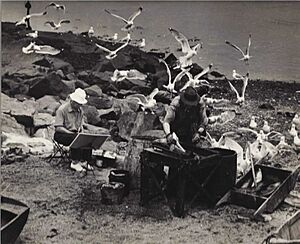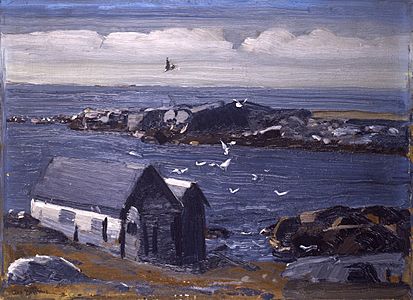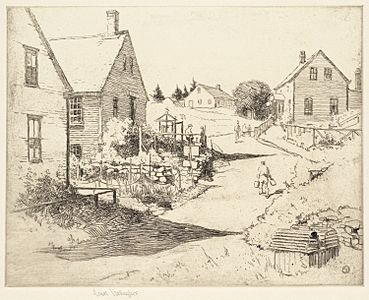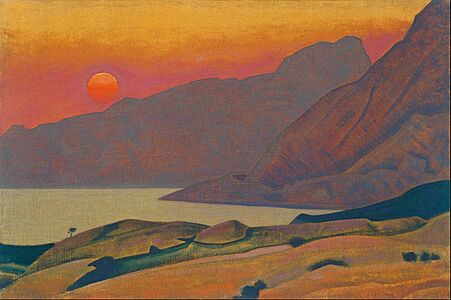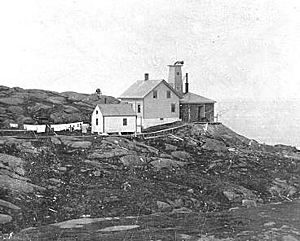Monhegan, Maine facts for kids
Quick facts for kids
Monhegan
|
|
|---|---|
|
Plantation
|
|
| Plantation of Monhegan Island | |
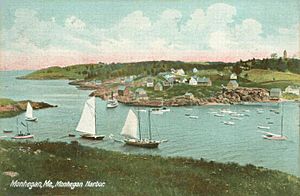
Monhegan Harbor in 1909
|
|
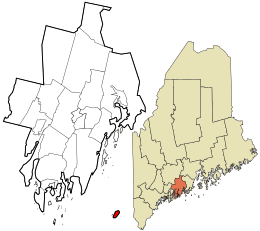
Location in Lincoln County and the state of Maine.
|
|
| Country | |
| State | |
| County | |
| Incorporated | 1839 |
| Area | |
| • Total | 4.5 sq mi (11.7 km2) |
| • Land | 0.9 sq mi (2.2 km2) |
| • Water | 3.7 sq mi (9.5 km2) |
| Elevation | 160 ft (0 m) |
| Population
(2020)
|
|
| • Total | 64 |
| • Density | 14.22/sq mi (5.47/km2) |
| Time zone | UTC-5 (Eastern (EST)) |
| • Summer (DST) | UTC-4 (EDT) |
| ZIP code |
04852
|
| Area code(s) | 207 |
| FIPS code | 23-46335 |
| GNIS feature ID | 0582600 |
| U.S. NNL | Designated: 1966 |
Monhegan (pronounced mon-HEE-gen) is a small island in the Gulf of Maine. It's a special type of community in Maine called a plantation. This means it's smaller than a town but has its own government. Monhegan is about 12 miles (19 km) off the coast of Lincoln County, Maine, in the United States.
In 2020, only 64 people lived here! The plantation includes Monhegan Island itself and the nearby island of Manana. You can reach Monhegan by boat from Boothbay Harbor, New Harbor, or Port Clyde. Cars are not allowed on the island, which helps keep it peaceful. In 1966, Monhegan was named a United States National Natural Landmark because of its unique plants and coastal features.
Contents
Exploring Monhegan's Past
The name Monhegan comes from the Abenaki word Monchiggon. This means "out-to-sea island." Samoset, an Abenaki leader, used this name. He was one of the first Native Americans to meet the Pilgrims in 1621.
Early European Visits
Many European explorers visited Monhegan early on. Martin Pring came in 1603, followed by Samuel de Champlain in 1604. George Weymouth arrived in 1605, and Captain John Smith visited in 1614.
A Hub for Fishing and Trade
Before the Pilgrims settled, Monhegan was a British fishing camp. Fishermen caught lots of Cod in the Gulf of Maine. They would dry the fish on special racks called "fish flakes" to preserve them. Then, the fish were shipped to Europe. A trading post was also built here. It was a busy place for trading with Native Americans, especially for valuable furs. In fact, Monhegan traders taught English to Samoset, who famously greeted the Pilgrims by saying, "Welcome, Englishmen."
Pirates and Conflicts
Monhegan even had a visit from pirates! On April 29, 1717, a pirate ship called the Anne arrived. These pirates were part of the crew of the famous pirate Samuel Bellamy. His main ship, the Whydah, had sunk in a storm. The pirates on the Anne waited for the Whydah, but it never came. They later attacked other ships nearby.
Monhegan was also caught in wars between New England (British) and New France (French). During King Philip's War (1675-1678), English settlers from the mainland found safety on the island. In King William's War (1688-1697), French forces captured Monhegan in 1689. They destroyed the fishing boats and burned buildings. Many people escaped to Massachusetts. Even when the island was empty, its harbor was still a useful stop for ships. Peace returned after the French and Indian War in 1763. Monhegan officially became an island plantation on September 4, 1839.
Lighthouse and Lobster Fishing
In 1824, a stone lighthouse was built on Monhegan. It was ordered by Congress and President James Monroe. Storms damaged it, so a new, stronger granite tower was built in 1850. A fog bell station was added in 1855 on Manana Island.
Monhegan has about 1,000 acres (400 ha) of good land. Farmers grew potatoes, but fishing was always the most important job. Even today, fishing is key to Monhegan's economy. From October to June, fishermen catch lobsters. Monhegan has the only lobster conservation area in Maine.
The Trefethen House is the oldest house on Monhegan Island. It used to be a hotel for visitors and is still standing today.
Monhegan's Art Community
Monhegan became a popular place for artists in the mid-1800s. By 1890, it was a well-known art colony. Many famous artists came to Monhegan for inspiration. These included Robert Henri, Frederick Judd Waugh, George Bellows, Edward Hopper, and Rockwell Kent.
Later artists like Jay Hall Connaway, Abraham Bogdanove, and Jamie Wyeth also found Monhegan inspiring. The tall, 150-foot (50 m) cliffs at Blackhead on the north side of the island have been a favorite subject for many Monhegan artists. The Monhegan Museum often celebrates the island's art history with special exhibits.
-
Monhegan. Maine (1922) by Nicholas Roerich (Google Art Project)
Monhegan's Geography
Monhegan Island is about 1.75 miles (2.8 km) long and 0.75 miles (1.2 km) wide. It is located in the Gulf of Maine, which is part of the Atlantic Ocean. The nearby Manana Island helps to create Monhegan Harbor, a safe place for boats. The total area of the island is about 4.5 square miles (11.7 km2). Most of this area is water, with only about 0.9 square miles (2.2 km2) being land.
Who Lives on Monhegan?
| Historical population | |||
|---|---|---|---|
| Census | Pop. | %± | |
| 1840 | 77 | — | |
| 1850 | 197 | 155.8% | |
| 1860 | 195 | −1.0% | |
| 1870 | 145 | −25.6% | |
| 1880 | 133 | −8.3% | |
| 1890 | 90 | −32.3% | |
| 1900 | 94 | 4.4% | |
| 1910 | 120 | 27.7% | |
| 1920 | 133 | 10.8% | |
| 1930 | 109 | −18.0% | |
| 1940 | 115 | 5.5% | |
| 1950 | 75 | −34.8% | |
| 1960 | 65 | −13.3% | |
| 1970 | 44 | −32.3% | |
| 1980 | 109 | 147.7% | |
| 1990 | 88 | −19.3% | |
| 2000 | 75 | −14.8% | |
| 2010 | 69 | −8.0% | |
| 2020 | 64 | −7.2% | |
| U.S. Decennial Census | |||
According to the census in 2000, there were 75 people living on Monhegan. The island had 46 households. The average age of people living there was 48 years old.
Fun Things to Do on Monhegan
During the summer, many artists and tourists visit Monhegan. They arrive by ferry at the landing or a beach in the village. The village has a church, homes, hotels, art studios, and a few small shops. You can even buy fresh fish and lobster!
Most of Monhegan is wild and open for exploring. There are about 17 miles (27 km) of hiking trails. These trails lead to high cliffs with amazing ocean views. Inland paths go through beautiful woods, including the famous Cathedral Woods. People sometimes build small "fairy houses" from natural materials in the woods.
The Monhegan Island Light (lighthouse) sits on a hill above the village. From there, you can see the whole village, the harbor, Manana Island, and the ocean. Next to the lighthouse is the Monhegan Museum. It's open from late June to September and shows items from the island's history.
Monhegan is also a great spot for birdwatching. It's on the Atlantic flyway, a route many birds use when they migrate. So, lots of different birds stop here, and birdwatchers come to see them.
Monhegan's library was first called the Jackie and Edward Library. It was named after two children who were lost in high waves on the island. It used to focus on children's books. Now it's called the Monhegan Memorial Library and has a wider selection of books.
Learning on the Island
In 2005, the Monhegan Island School had seven students, from kindergarten to eighth grade. All of them were taught by one teacher! Older students (high school) have to go to school on the mainland. The schoolhouse is also a community center. It hosts events like the annual Christmas play and community dinner.
Famous People Connected to Monhegan
Many interesting people have lived on or visited Monhegan Island regularly:
- George Bellows, artist
- Abraham Bogdanove, artist
- Jon Bogdanove, comic book artist
- Kate Chappell, artist, entrepreneur
- Tom Chappell, entrepreneur
- Jay Hall Connaway, artist
- Edward L. Deci, professor
- Lynne Drexler, artist
- Theodore Miller Edison, businessman
- Ernest Fiene, artist
- Sears Gallagher, artist
- Robert Henri, artist
- Edward Hopper, artist
- Wilson Irvine, artist
- Elena Jahn, artist
- Rockwell Kent, artist
- Frances Kornbluth, artist
- Josh Mostel, actor
- Zero Mostel, actor
- Robert Mrazek, congressman from New York
- Remak Ramsay, actor
- Edward Redfield, artist
- Samoset, Abenaki sagamore
- Sonya Sklaroff, artist
- Frederick Judd Waugh, artist
- Andrew Winter, artist
- Andrew Wyeth, artist
- Jamie Wyeth, artist
- N.C. Wyeth, artist
Images for kids
See also
 In Spanish: Monhegan para niños
In Spanish: Monhegan para niños


